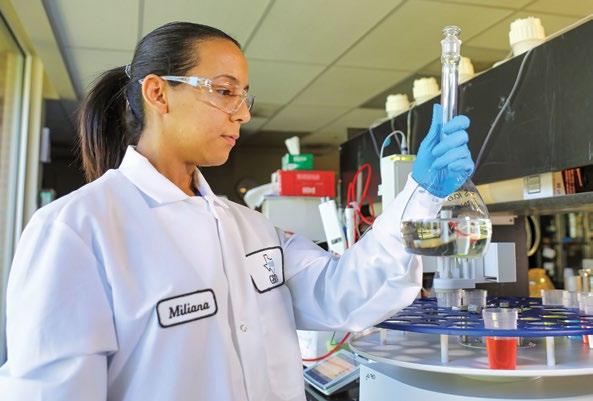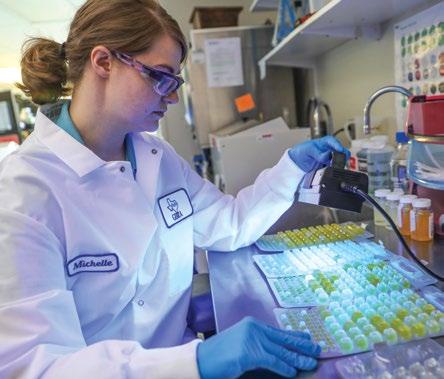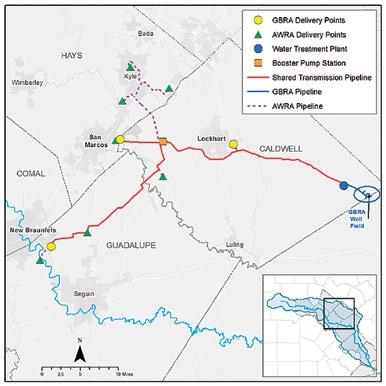
4 minute read
GBRA Lab Key to Water Health
Over the course of a year, the GBRA water quality lab will analyze and report on more than 12,000 water and wastewater samples. Using the most current scientific analysis processes and equipment, the team of 10 environmental scientists ensure GBRA’s mission of supporting responsible watershed protection and stewardship is always improving.
“You’ve heard the saying that ‘numbers don’t lie.’ Essentially, that is what our lab’s work is about. We generate the numbers from water and wastewater quality analyses that indicate the overall quality of the water in the Guadalupe and Blanco rivers watersheds,” stated Kylie Gudgell, GBRA regional lab director. “We employ testing techniques that have been used for decades and some that are relatively new science. We are constantly looking for the best ways to gain the best data from our water and wastewater quality sampling because, in the end, those numbers are the keys to letting the public know about the overall health of the environment they live in.” Gudgell’s focus on science gives you an indicator that water quality labs like GBRA’s are heavily regulated and monitored. The GBRA lab is a certified drinking water laboratory, which has adopted the exacting standards of the National Environmental Laboratory Accreditation Program (NELAP). About 10 years ago, the Texas Commission on Environmental Quality (TCEQ), the State’s environmental regulatory agency, adopted a position that only NELAP-certified labs would be able to submit official data to the State for permitting purposes.
Advertisement
With GBRA operating numerous water and wastewater plants throughout its service area, the lab stays busy each month helping the plant operators ensure their facilities meet all permit requirements. The lab analyzes the water samples, works with the plant operators on any follow up testing that might be required, and then reports results to TCEQ through its web portal.
A laboratory technician testing for Alkalinity in water samples.
A laboratory technician routinely testing for E.coli bacteria in river water.
The GBRA lab also provides TCEQ approved lab services for municipal and public water and wastewater systems.
In addition to all of the water quality testing and analysis analysis, the lab does find time for the agency’s water and wastewater plants, the lab does find time to help individual homeowners with questions they may have about private water wells.
“We do get questions from people who have purchased a home with a water well,” Gudgell noted. “The first thing we advise is the water be tested for bacteria. The presence of coliform bacteria, specifically E. coli, in drinking water can cause all kinds of health problems like nausea, headaches, fever and even more serious issues. The second most important testing is for nitrates. Too many nitrates in the well water can be harmful to older people and children. Nitrates can reduce the amount of oxygen your blood can take up and use. In addition to the water sampling discussion, we also ask questions about the age of the home that can inform us to whether they might have older, lead or other metal pipes in their home’s plumbing system. We can do the water quality tests for well owners and we only recover the costs we incur for that work. So, while this type of work is not on as grand of a scale as we do for other customers, this service is quite important because the health of a family is at stake.”
Outside of completing the essential water and wastewater quality testing for GBRA’s plants each month and handling questions from the public, Gudgell said the team likes to participate in special research projects. One such study they are currently involved in is with the Texas Institute for Applied Environmental Research. TIAER, created by the Texas Legislature in 1991, is based at Tarleton State University in Stephenville, Texas.

“This particular study with TIAER looks at the best way to measure chlorophyll-a occurring in lakes,” Gudgell explained. “The concentration of chlorophyll-a in lake water relates to the amount of algae living in the water. Excessive algae not only gives water bodies an undesirable appearance but is also an indicator of nutrient levels and the overall quality of the water. We have been working on this project since last summer and Phase II will continue through spring 2020. There are a couple of ways to conduct chlorophyll-a testing and this project will help the industry determine the most precise testing process.
“While it’s easy to get caught up in the analysis of numbers we do in the lab, we always try and keep in mind that our work goes directly to helping GBRA and other communities improve the ways we protect and improve the quality in streams, lakes and the bays. If the lab finds certain contaminants in surface water or groundwater, then other teams of environmental scientists and engineers can assess the origins of the problem and develop measurable means to address them. Additionally, the better the data we deliver, the better decisions policymakers can make. And all of that work only helps improve the quality of life for all Texans.”







